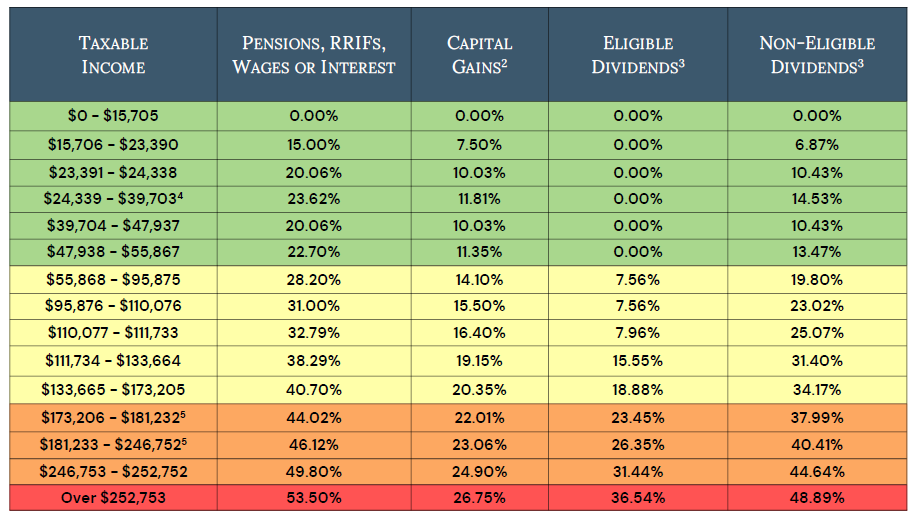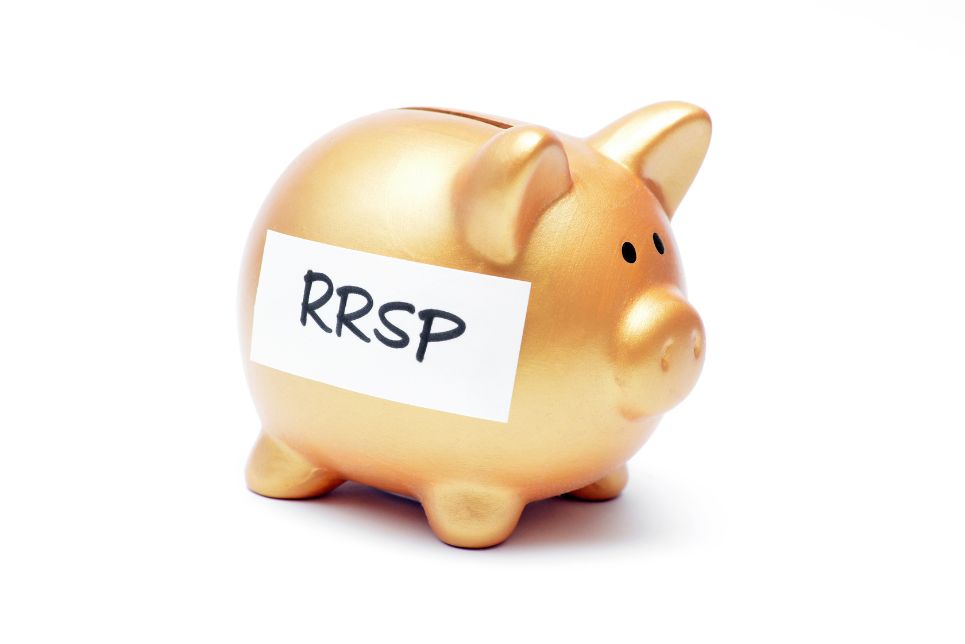5 Key Tactics for Effective Tax Planning

As we come to the end of another tax season, we’d like to return to some of the basics of financial planning and the value that your Alitis Wealth Planning Team provides through 5 categories of tax planning:
- Income Deferral
- Income Splitting
- Income Spreading
- Tax Sheltering
- Tax Credit/Deduction Maximization
The objective of good tax planning is to structure your affairs in a legal fashion to minimize the amount of tax you pay. While there isn’t enough space in this article to go through the detailed specifics of good tax planning, know that there is a team of professionals that are always looking for opportunities to create efficiencies and savings in your planning and, ultimately, to maximize your wealth.
As a review, Canada’s tax system is based on a graduated system meaning that as your taxable income climbs into the next bracket those dollars will be taxed at progressively higher rates. The following chart illustrates these brackets in BC for 2024.
Combined Federal & Provincial (BC) Personal Taxes – 2024 Tax Year1

Income Deferral

Income deferral is the first tax planning strategy that we consider. Given the choice of paying a tax bill today or in the future when you may be in a lower tax bracket, which would you choose? Unsurprisingly, most of us would defer the tax bill for as long as possible to take advantage of being in a lower tax bracket. Programs like Registered Retirement Savings Plans (RRSPs) fit into this category. In some cases, it may be best to defer converting your RRSPs over to a Registered Retirement Income Fund (RRIF) until it is mandatory, which is December 31st of the year you turn 71. There are situations when earlier, gradual withdrawals will lead to a lower overall tax cost. This is a calculation we factor in when completing our Retirement Income Projections and finding the optimal balance between paying taxes today and throughout your retirement.
Income Splitting

Income splitting is when we look for opportunities to ensure that each dollar earned within a household is taxed at the lowest marginal rate. Because of our graduated tax system, it is more beneficial for two people to have incomes of $50,000 each than to have one spouse at $70,000 and the other at $30,000. For retired couples, income from sources such as CPP, pension income, RRIF, LIF, annuities, and joint investment accounts can be shared to ensure that as a household, you are paying the least amount of tax possible. For couples in their accumulation years, strategies such as TFSAs, spousal RRSPs, or having the spouse with the higher income cover household expenses and the spouse with the lower income invest are useful tactics for this life phase.
Income Spreading

Investments produce one of three types of income: interest, dividends, or capital gains. The objective of our team is to place your investments in the proper investment vehicles for the greatest tax efficiency through income spreading. The most highly taxed form of investment income in taxable accounts is interest, as all of it is taxed at one’s top marginal rate. Eligible dividend income from Canadian corporations receives favorable tax credits and is often taxed at the lowest rate and can result in a negative tax rate by shifting the dividend tax credit to offset other income at the lower income brackets. And finally, capital gains in which you are taxed on 50% of your gain when the gain is realized. For example, generally, you’d place your interest-generating investments in a registered account such as an RRSP and your dividend-producing and capital gains generating investments in your non-registered, taxable, personal, or corporate account. Two levels of tax savings occur with this planning:
- Immediate annual tax savings on the taxable (Cash) account because you’ve now allocated 100% of the eligible dividend income and capital gains in the Cash account.
- Lower tax on withdrawals and terminal taxes (when you pass) in the RRSP/RIF/LIF account.
Tax Sheltering

The fourth tactic of good tax planning is to make full use of all available tax shelters to eliminate the effect of income on investments. In 2009, the federal government introduced Tax-Free Savings Accounts (TFSAs) and since that time we have used these accounts as an effective tool to shelter all the gains from tax and to shift the least efficient/high income (income spreading) producing investments to these accounts.
Assuming you were 18 in 2009, your total TFSA contribution room in 2024 would be $95,000. If your TFSA is fully funded and you’re looking for another tax shelter where investment earnings might grow tax-free, a lesser-known strategy that is often overlooked is permanent life insurance. Participating Whole Life and Universal Life Insurance are viable products that can be used to complement other types of accounts. Life insurance can be a highly effective vehicle to deposit savings that can compound tax-exempt and build a considerable capital value that can be gifted to another family member or charity without any tax payable by the beneficiary. Families with surplus cash flow or investment accounts can reallocate some of these taxable investments to a tax-free permanent insurance strategy that will still earn a competitive return on par with a taxable, balanced portfolio. Permanent life insurance has some similar features to a TFSA and without any annual limits; this is using life insurance as a pure investment strategy and not for family protection. The earlier you start a plan, the lower the internal cost of insurance, making the plan compound even more effectively.
Tax Credit/Deduction Maximization

Finally, we look to help you maximize available tax deductions and credits and understand the difference between these. A tax credit reduces the amount of tax owing, and a tax deduction reduces the amount of your gross income that is subject to income tax. For those still immersed in their working years, maximizing your RRSPs provides a deduction that will save you money on your income tax by deferring tax at your top marginal tax rate. Refundable tax credits are paid to anyone who qualifies for them, whether they have income or not with the most well-known being the GST/HST payment. Additionally, there are non-refundable tax credits such as Age, Pension Income, Disability Amount, Medical Expenses, Charitable Contributions, etc. that are available depending upon the phase of life you are presently in and your personal circumstances.
For individuals seeking the tax and social benefits of donating to charities, it is advisable to check CRA’s website to ensure that the charity of choice is a “qualified donee” before making that gift and talk to your Portfolio Manager, Certified Financial Planner, and accountant to ensure that the gift is structured in the most efficient and meaningful way. All the above illustrated examples showcase the various possibilities that an individual or a household can undertake to pay less tax. These legal tax strategies offer ways to increase after-tax returns simply by paying less tax.
As your Alitis Wealth Management Team, we invite you to be curious at your next review and ask us if you are taking full advantage of the many strategies that exist for you to reduce your taxes now and in the future. And, rest assured that as students of our industry, we continue to seek out ways to enrich your planning. This is the Alitis way.
Sincerely,
Shawn Fetter, CIM®, CFP®, CLU®
Certified Financial Planner
Insurance Advisor
Alitis Wealth Planning
Contact Us
Schedule a no-obligation, complimentary meeting today. Find Alitis Wealth Services in Campbell River at 101-909 Island Highway, in the Comox Valley at 103-695 Aspen Rd., in Victoria at 1480 Fort St., and online at alitis.ca/wealth-planning. For more information, call 1-800-667-2554 or email info@alitis.ca.
Disclaimers and Disclosures
- Stephenson, Amanda. “Canadians Now Expect to Need $1.7m in Order to Retire: BMO Survey – BNN Bloomberg.” BNN, The Canadian Press, 7 Feb. 2023, https://www.bnnbloomberg.ca/canadians-now-expect-to-need-1-7m-in-order-to-retire-bmo-survey-1.1880425.

